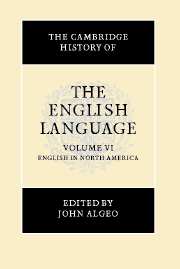Book contents
- Frontmatter
- 1 EXTERNAL HISTORY
- 2 BRITISH AND AMERICAN, CONTINUITY AND DIVERGENCE
- 3 BRITISH AND IRISH ANTECEDENTS
- 4 CONTACT WITH OTHER LANGUAGES
- 5 AMERICANISMS
- 6 SLANG
- 7 DIALECTS
- 8 AFRICAN-AMERICAN ENGLISH
- 9 GRAMMATICAL STRUCTURE
- 10 SPELLING
- 11 USAGE
- 12 CANADIAN ENGLISH
- 13 NEWFOUNDLAND ENGLISH
- 14 American English Abroad
- Glossary of Linguistic Terms
- Bibliography
- Index
- THE CAMBRIDGE HISTORY OF THE ENGLISH LANGUAGE
8 - AFRICAN-AMERICAN ENGLISH
Published online by Cambridge University Press: 28 March 2008
- Frontmatter
- 1 EXTERNAL HISTORY
- 2 BRITISH AND AMERICAN, CONTINUITY AND DIVERGENCE
- 3 BRITISH AND IRISH ANTECEDENTS
- 4 CONTACT WITH OTHER LANGUAGES
- 5 AMERICANISMS
- 6 SLANG
- 7 DIALECTS
- 8 AFRICAN-AMERICAN ENGLISH
- 9 GRAMMATICAL STRUCTURE
- 10 SPELLING
- 11 USAGE
- 12 CANADIAN ENGLISH
- 13 NEWFOUNDLAND ENGLISH
- 14 American English Abroad
- Glossary of Linguistic Terms
- Bibliography
- Index
- THE CAMBRIDGE HISTORY OF THE ENGLISH LANGUAGE
Summary
What is African-American English?
The term African-American English (AAE) is used here for “the whole range of language [varieties] used by black people in the United States: a very large range indeed, extending from the Creole grammar of Gullah spoken in the Sea Islands [and coastal marshlands] of South Carolina [and Georgia] to the most formal and accomplished literary style” (Labov 1972a, xiii). This chapter is focused, however, on vernacular varieties characterized as basilectal or mesolectal. A basilect is a variety most different from educated, middle-class English, called an acrolect, and a mesolect is intermediate between the basilect and the acrolect.
The term AAE is used here as a general, umbrella term that must be distinguished from more specific ones such as Gullah – also known as Sea Island Creole – and African-American vernacular English (AAVE). Gullah is any of a range of creole varieties, and AAVE is any of the continental nonstandard varieties of African-American speech. Following several African-American scholars (J. Baugh 1983; M. Morgan 1989; Smitherman 1977; Spears 1988; Tolliver-Weddington) but in contrast with William Labov (1972a, cf. however 1982) and others, the term “vernacular” is used here for varieties of AAE allegedly used by 80 to 90 percent of continental African-Americans as a primary means of communication for their day-to-day intragroup communication (Smitherman 1977, 2; Spears 1988, 109; Wofford 367). That percentage is only an estimate suggesting that most African-Americans speak those varieties of AAE.
- Type
- Chapter
- Information
- The Cambridge History of the English Language , pp. 291 - 324Publisher: Cambridge University PressPrint publication year: 2001
- 13
- Cited by

